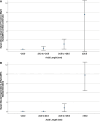Prevalence of Myopic Maculopathy Among the Very Old: The Ural Very Old Study
- PMID: 38512243
- PMCID: PMC10960226
- DOI: 10.1167/iovs.65.3.29
Prevalence of Myopic Maculopathy Among the Very Old: The Ural Very Old Study
Abstract
Purpose: To assess the prevalence of myopic macular degeneration (MMD) in very old individuals.
Methods: The population-based Ural Very Old Study (UVOS) included 1526 (81.1%) of 1882 eligible inhabitants aged ≥85 years. Assessable fundus images were available for 930 (60.9%) individuals (mean age, 88.6 ± 2.7 years). MMD was defined by macular patchy atrophies (i.e., MMD stage 3 and 4 as defined by the Pathologic Myopia Study Group).
Results: MMD prevalence was 21 of 930 (2.3%; 95% CI, 1.3-3.3), with 10 individuals (1.1%; 95% CI, 0.4-1.7) having MMD stage 3 and 11 participants (1.2%; 95% CI, 0.5-1.9) MMD stage 4 disease. Within MMD stage 3 and 4, prevalence of binocular moderate to severe vision impairment was 4 of 10 (40%; 95% CI, 31-77) and 7 of 11 (64%; 95% CI, 30-98), respectively, and the prevalence of binocular blindness was 2 of 10 (20%; 95% CI, 0-50) and 3 of 11 (27%; 95% CI, 0-59), respectively. In minor myopia (axial length, 24.0 to <24.5 mm), moderate myopia (axial length, 24.5 to <26.5 mm), and high myopia (axial length, ≥26.5 mm), MMD prevalence in the right eyes was 0 of 46 eyes (0%), 3 of 40 eyes (8%; 95% CI, 0-16), and 7 of 9 (78%; 95% CI, 44-100), respectively; MMD prevalence in the left eyes was 1 in 48 eyes (2%; 95% CI, 0-6), 4 of 36 eyes (11%; 95% CI, 0-22), and 3 of 4 eyes (75%; 95% CI, 0-100), respectively. In multivariable analysis, a higher MMD prevalence (odds ratio, 8.89; 95% CI, 3.43-23.0; P < 0.001) and higher MMD stage (beta, 0.45; B, 19; 95% CI, 0.16-0.22; P < 0.001) were correlated with longer axial length but not with any other ocular or systemic parameter.
Conclusions: MMD prevalence (stages 3 and 4) in very old individuals increased 8.89-fold for each mm axial length increase, with a prevalence of ≥75% in highly myopic eyes. In old age, highly myopic individuals have a high risk of eventually developing MMD with marked vision impairment.
Conflict of interest statement
Disclosure:
Figures


References
-
- Hsu WM, Cheng CY, Liu JH, Tsai SY, Chou P.. Prevalence and causes of visual impairment in an elderly Chinese population in Taiwan: the Shihpai Eye Study. Ophthalmology. 2004; 111(1): 62–69. - PubMed
-
- Xu L, Wang Y, Li Y, et al. .. Causes of blindness and visual impairment in urban and rural areas in Beijing: the Beijing Eye Study. Ophthalmology. 2006; 113(7): 1134–1141. - PubMed
-
- Vongphanit J, Mitchell P, Wang JJ.. Prevalence and progression of myopic retinopathy in an older population. Ophthalmology. 2002; 109(4): 704–711. - PubMed
-
- Fang Y, Yokoi T, Nagaoka N, et al. .. Progression of myopic maculopathy during 18-year follow-up. Ophthalmology. 2018; 125(6): 863–877. - PubMed
-
- Yan YN, Wang YX, Yang Y, et al. .. Ten-year progression of myopic maculopathy: the Beijing Eye Study 2001-2011. Ophthalmology. 2018; 125(8): 1253–1263. - PubMed
MeSH terms
LinkOut - more resources
Full Text Sources
Medical

